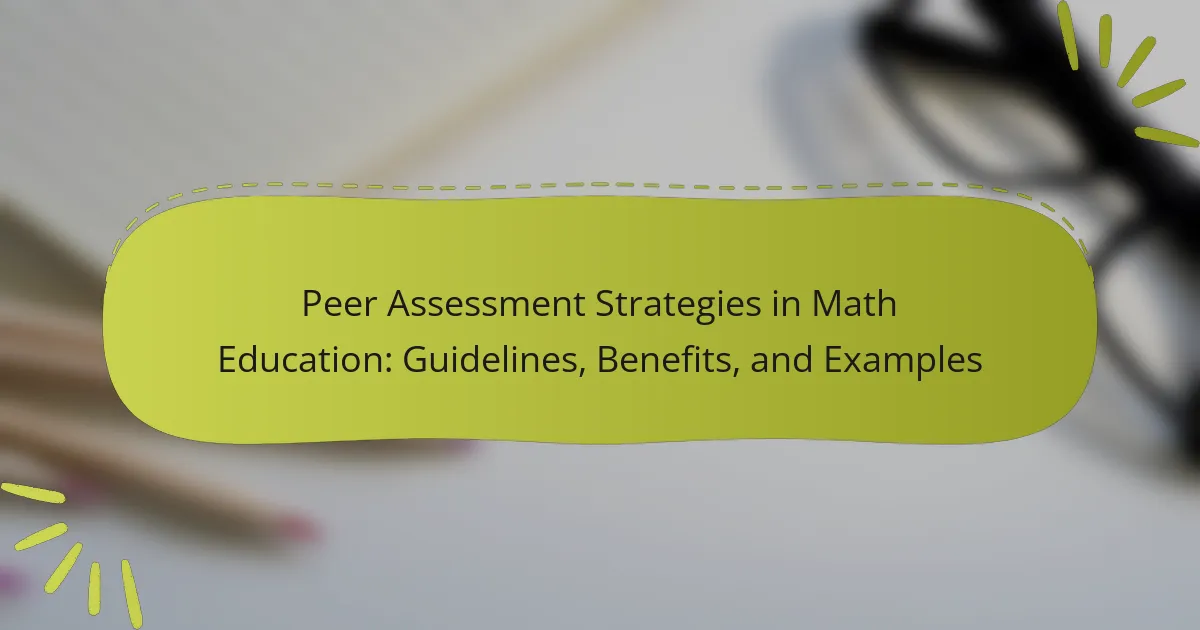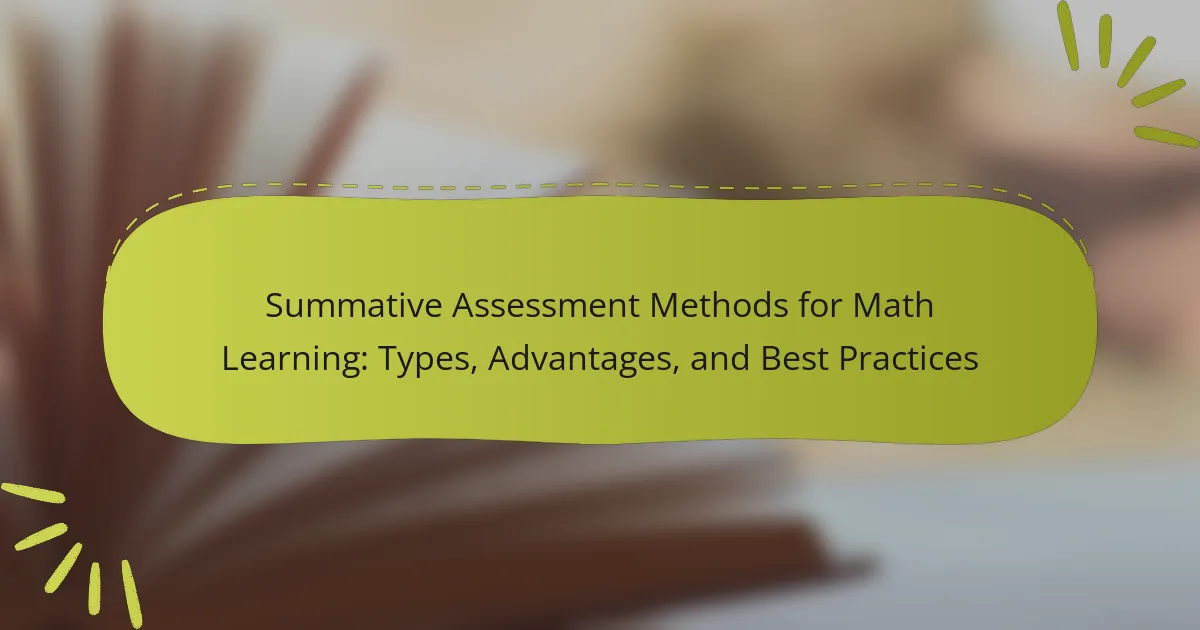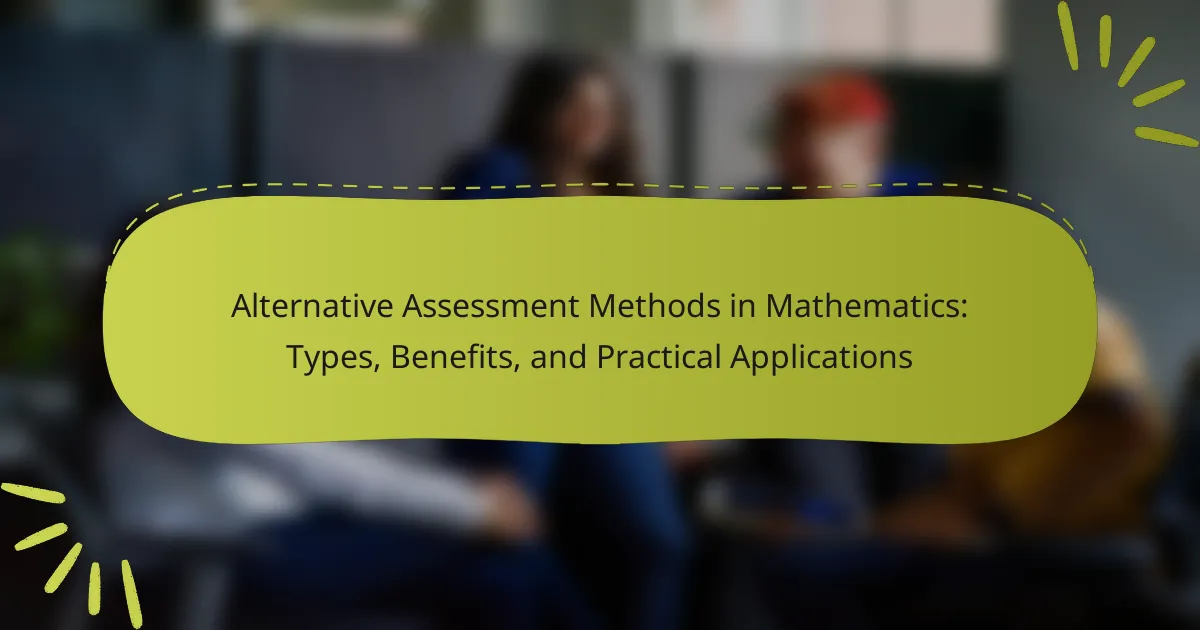Formative assessment techniques in mathematical education are essential methods for evaluating student learning throughout the instructional process. These techniques, which include quizzes, peer assessments, and observational assessments, provide continuous feedback to both students and teachers, enabling real-time identification of student understanding and misconceptions. Research indicates that implementing these techniques can enhance student achievement significantly, with studies demonstrating potential learning gains of up to 20%. The article explores the benefits of formative assessments in promoting active learning, fostering a growth mindset, and creating a supportive learning environment, while also outlining effective strategies for their implementation in educational settings.
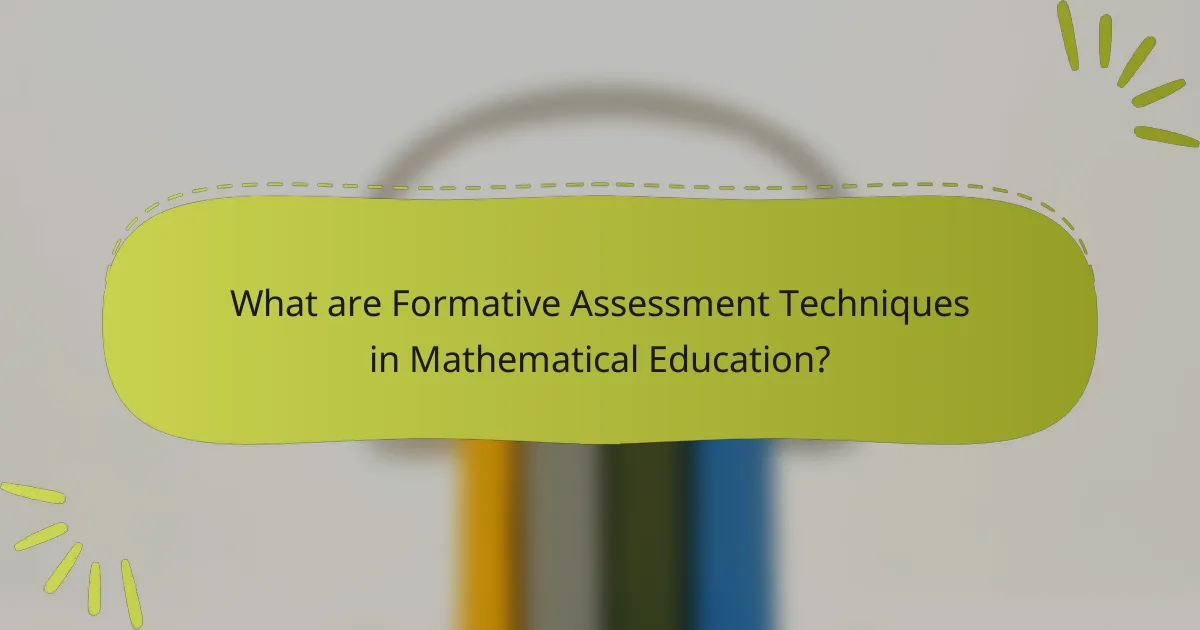
What are Formative Assessment Techniques in Mathematical Education?
Formative assessment techniques in mathematical education are methods used to evaluate student learning during instruction. These techniques provide ongoing feedback to both students and teachers. Common techniques include quizzes, peer assessments, and observational assessments. They help identify student understanding and misconceptions in real-time. Research shows that formative assessments can enhance student achievement by 20%. This is supported by studies such as Black and Wiliam’s (1998) work on formative assessment. These techniques allow for adjustments in teaching strategies to improve learning outcomes.
How do formative assessments differ from summative assessments?
Formative assessments are ongoing evaluations used to monitor student learning during the instructional process. They aim to provide feedback that can be used to improve teaching and learning. Examples include quizzes, discussions, and observations. Summative assessments, on the other hand, evaluate student learning at the end of an instructional unit. They typically occur after a period of learning and are used to measure overall achievement. Common forms include final exams and standardized tests. The key difference lies in their purpose and timing; formative assessments guide instruction, while summative assessments measure the effectiveness of that instruction.
What are the key characteristics of formative assessments?
Formative assessments are ongoing evaluations used to monitor student learning. They provide immediate feedback to both students and educators. These assessments help identify areas where students struggle. They can take various forms, such as quizzes, discussions, or observations. Formative assessments are typically low-stakes, meaning they do not heavily impact final grades. They encourage student engagement and active participation. Research shows that formative assessments can significantly enhance learning outcomes. For example, a study by Black and Wiliam (1998) found that effective formative assessment practices can lead to substantial improvements in student achievement.
Why are formative assessments crucial in mathematical education?
Formative assessments are crucial in mathematical education because they provide ongoing feedback to both students and educators. These assessments help identify students’ understanding and misconceptions in real-time. This enables instructors to adjust their teaching strategies accordingly. Research shows that formative assessments can significantly enhance student learning outcomes. A study by Black and Wiliam (1998) found that students who received regular feedback improved their performance by an average of 30 percentile points. Additionally, formative assessments foster a growth mindset, encouraging students to view challenges as opportunities for learning. They promote active engagement and self-reflection, which are essential for mastering mathematical concepts. Overall, formative assessments are integral to creating an effective learning environment in mathematics education.
What types of formative assessment techniques are commonly used?
Common types of formative assessment techniques include quizzes, observations, peer assessments, and self-assessments. Quizzes can be short and focused on specific learning objectives. Observations allow educators to gauge student understanding during lessons. Peer assessments encourage collaboration and critical thinking among students. Self-assessments promote reflection on personal learning progress. These techniques provide immediate feedback, enabling instructional adjustments. Research indicates that formative assessments enhance student engagement and learning outcomes.
How can observations be utilized as a formative assessment technique?
Observations can be utilized as a formative assessment technique by allowing educators to assess student understanding in real-time. This method involves watching students as they engage with mathematical tasks. Educators can identify misconceptions or gaps in knowledge during these observations. They can also gather insights into student problem-solving strategies and collaborative skills. Observations provide immediate feedback, enabling timely interventions. Research shows that formative assessments improve student learning outcomes by 20% (Hattie, 2009). Thus, utilizing observations effectively can enhance the educational experience in mathematics.
What role do quizzes and exit tickets play in formative assessments?
Quizzes and exit tickets serve as essential tools in formative assessments. They provide immediate feedback on student understanding. Quizzes can gauge knowledge retention and identify areas needing improvement. Exit tickets allow students to reflect on their learning at the end of a lesson. Both methods encourage active participation and engagement. Research shows that these tools can enhance student learning outcomes. For example, a study by Black and Wiliam (1998) found that effective formative assessment practices significantly improve student performance. Thus, quizzes and exit tickets are vital for monitoring progress in educational settings.
How can peer assessments enhance formative evaluation in mathematics?
Peer assessments can enhance formative evaluation in mathematics by promoting collaborative learning and critical thinking. They allow students to engage with each other’s work, fostering a deeper understanding of mathematical concepts. Through peer feedback, students can identify gaps in their knowledge and receive diverse perspectives on problem-solving approaches. Research indicates that peer assessment increases student motivation and accountability, as learners take ownership of their evaluations. Studies show that students who participate in peer assessments demonstrate improved performance on subsequent assessments. This method also helps teachers gather insights into student understanding, allowing for targeted instructional adjustments. Overall, peer assessments create an interactive learning environment that supports continuous improvement in mathematical education.
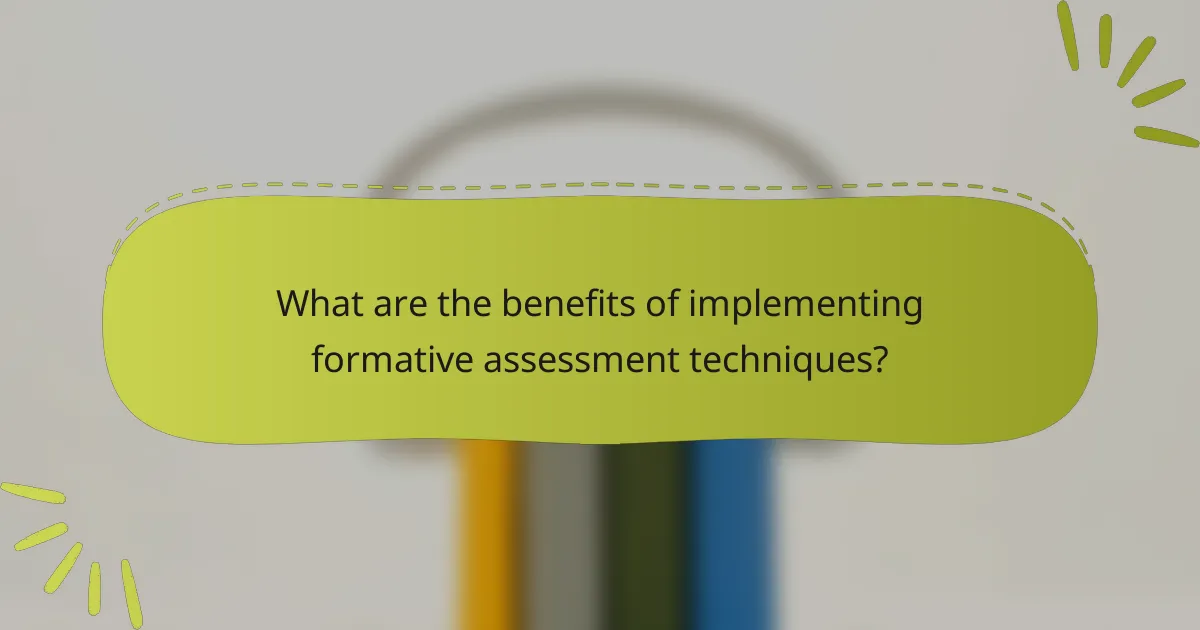
What are the benefits of implementing formative assessment techniques?
Implementing formative assessment techniques enhances student learning and engagement. These techniques provide ongoing feedback to both teachers and students. They help identify areas where students struggle, allowing for timely interventions. Formative assessments promote active learning and encourage student participation. Research indicates that students who receive regular feedback perform better academically. A study by Black and Wiliam (1998) found that formative assessment can lead to significant learning gains. Additionally, these techniques foster a growth mindset among students. They encourage self-reflection and help students take ownership of their learning process. Overall, formative assessments create a supportive learning environment that benefits all students.
How do formative assessments improve student learning outcomes?
Formative assessments improve student learning outcomes by providing ongoing feedback during the learning process. They allow educators to identify students’ strengths and weaknesses in real-time. This enables targeted instruction tailored to individual needs. Research indicates that formative assessments can increase student achievement by up to 30%. According to Hattie and Timperley’s meta-analysis, feedback from formative assessments significantly boosts learning. By engaging students in self-assessment, they develop metacognitive skills. This leads to greater ownership of their learning. Formative assessments also foster a growth mindset, encouraging persistence and resilience. Overall, they create a more responsive learning environment that enhances academic performance.
What impact do formative assessments have on student engagement?
Formative assessments significantly enhance student engagement. They provide immediate feedback, allowing students to understand their learning progress. This feedback encourages active participation and motivates students to take ownership of their learning. Research shows that students involved in formative assessments are more likely to stay focused and engaged during lessons. A study by Black and Wiliam (1998) found that formative assessment practices lead to higher achievement and increased motivation among students. Furthermore, these assessments create a supportive learning environment, fostering collaboration and communication among peers. Overall, formative assessments play a crucial role in promoting sustained student engagement in educational settings.
How can formative assessments guide instructional practices?
Formative assessments guide instructional practices by providing real-time feedback on student understanding. Teachers can identify learning gaps and adjust their teaching strategies accordingly. This approach fosters a responsive learning environment. Research shows that formative assessments can improve student achievement by up to 30%. For example, a study by Black and Wiliam (1998) found that effective formative assessment practices significantly enhance student performance in mathematics. By continuously monitoring progress, educators can tailor instruction to meet diverse student needs. This dynamic process ultimately leads to improved educational outcomes.
What advantages do formative assessments offer teachers?
Formative assessments provide teachers with immediate feedback on student understanding. This feedback allows teachers to adjust instruction in real-time. Teachers can identify learning gaps and misconceptions quickly. Formative assessments promote a more personalized learning experience. They encourage student engagement and participation in the learning process. Research shows that formative assessments can enhance student achievement. For example, a study by Black and Wiliam (1998) found that formative assessment practices can lead to significant improvements in student performance. Overall, formative assessments support effective teaching and learning strategies.
How do formative assessments help in identifying student misconceptions?
Formative assessments help in identifying student misconceptions by providing ongoing feedback during the learning process. These assessments can take various forms, such as quizzes, discussions, or observational tasks. They allow educators to gauge students’ understanding in real-time. By analyzing student responses, teachers can pinpoint specific areas of misunderstanding. For instance, if multiple students struggle with a particular concept, it signals a common misconception. Research shows that formative assessments can improve learning outcomes by addressing these misconceptions promptly. According to a study by Black and Wiliam (1998), formative assessment practices lead to significant gains in student achievement.
What insights can teachers gain from analyzing formative assessment data?
Teachers can gain insights into student understanding and learning gaps by analyzing formative assessment data. This data reveals how well students grasp concepts during the learning process. It helps identify areas where students struggle, allowing for targeted interventions. Teachers can adjust their instructional strategies based on the analysis. For example, specific misconceptions can be addressed in real-time. Furthermore, formative assessment data can guide the development of personalized learning plans. By tracking progress over time, teachers can measure the effectiveness of their teaching methods. Research indicates that effective use of formative assessments can lead to improved student outcomes.
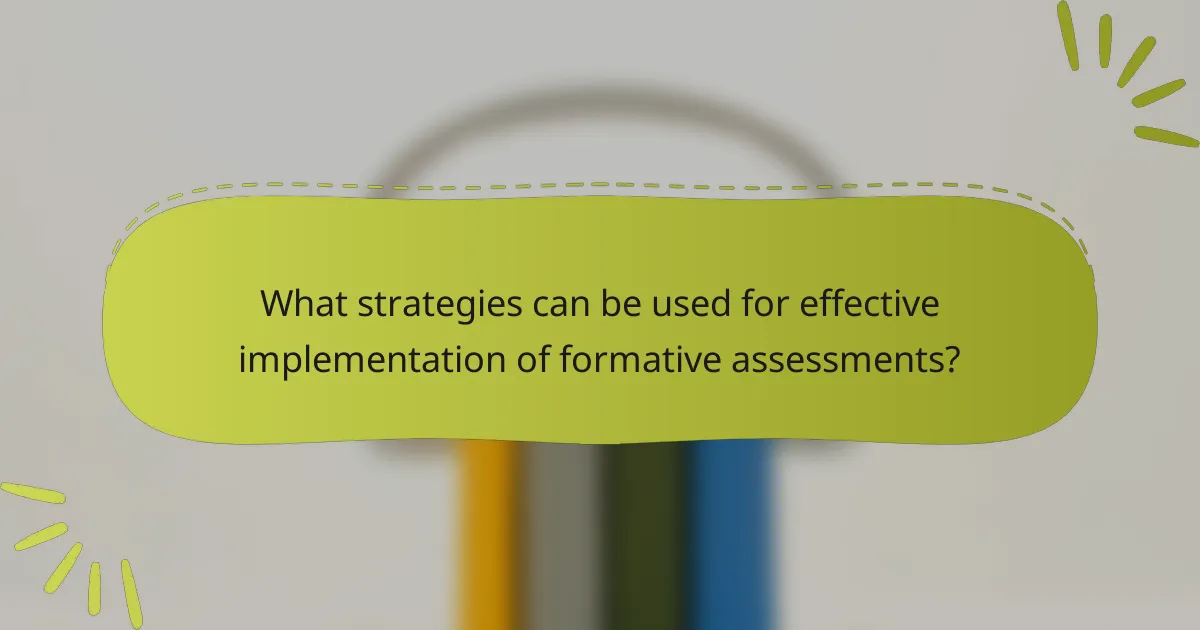
What strategies can be used for effective implementation of formative assessments?
Effective implementation of formative assessments involves several strategies. First, clear learning objectives should be established. These objectives guide what students need to learn. Next, regular feedback is essential. Timely feedback allows students to understand their progress. Incorporating diverse assessment methods enhances engagement. Techniques can include quizzes, peer assessments, and self-assessments. Additionally, fostering a supportive classroom environment encourages open communication. Students should feel comfortable sharing their thoughts. Lastly, using data to inform instruction is crucial. Analyzing assessment results helps educators tailor their teaching approaches. These strategies collectively enhance the effectiveness of formative assessments in educational settings.
How can teachers design effective formative assessment activities?
Teachers can design effective formative assessment activities by incorporating clear learning objectives. Each activity should align with specific educational goals. Using diverse assessment methods enhances engagement. Techniques may include quizzes, peer assessments, or observational checklists. Feedback should be timely and constructive to guide student improvement. Incorporating student self-assessments promotes ownership of learning. Regularly revising assessment strategies based on student performance is essential. Research indicates that formative assessments can significantly improve student outcomes when implemented effectively.
What considerations should be made when creating assessment criteria?
When creating assessment criteria, clarity and alignment with learning objectives are crucial. Clear criteria help students understand expectations. Alignment ensures assessments measure the intended learning outcomes. Specificity is also important; criteria should detail what constitutes successful performance. This allows for objective evaluation. Additionally, inclusivity should be considered. Criteria must accommodate diverse learning styles and needs. Finally, feedback mechanisms should be integrated into the criteria. This promotes continuous improvement and learning.
How can technology facilitate formative assessments in the classroom?
Technology facilitates formative assessments in the classroom by providing real-time feedback and interactive tools. Digital platforms allow teachers to create quizzes and surveys that students can complete instantly. This immediate feedback helps identify areas where students struggle. Educational apps can track student progress over time. Analytics from these tools can inform instructional adjustments. Tools like Google Forms or Kahoot make assessments engaging and accessible. Research shows that technology integration improves student motivation and learning outcomes. For instance, a study by the Bill & Melinda Gates Foundation indicates that technology-enhanced formative assessments lead to better academic performance.
What challenges might educators face when implementing formative assessments?
Educators may face several challenges when implementing formative assessments. One significant challenge is time constraints. Educators often struggle to find sufficient time within the curriculum to administer and analyze assessments. Additionally, there may be a lack of training on effective formative assessment strategies. Research indicates that without proper training, educators may not utilize assessments to their full potential. Another challenge is student engagement. Some students may not take formative assessments seriously, diminishing their effectiveness. Furthermore, interpreting assessment data can be complex. Educators need to accurately analyze results to inform instruction. Finally, there may be resistance to change from traditional assessment methods. This resistance can hinder the adoption of new practices in the classroom.
How can teachers overcome resistance to formative assessment techniques?
Teachers can overcome resistance to formative assessment techniques by providing clear communication about their benefits. Educators should explain how these assessments can enhance student learning and engagement. Training sessions can help teachers understand the practical applications of these techniques. Collaborative planning with peers can foster a supportive environment for implementing new strategies. Sharing success stories from other educators can build trust and credibility. Regular feedback loops allow teachers to adjust their approaches based on student responses. Research indicates that formative assessments lead to improved student performance and motivation. A study by Black and Wiliam (1998) highlights that effective formative assessment can significantly enhance learning outcomes.
What strategies can be employed to ensure consistent implementation?
Establishing clear protocols is essential for consistent implementation. These protocols should include detailed guidelines for educators to follow. Regular training sessions can reinforce these protocols and enhance teacher confidence. Monitoring and feedback mechanisms must be in place to assess adherence to the protocols. Collaboration among educators fosters a shared understanding and consistency in application. Utilizing technology can streamline the implementation process and provide real-time data. Setting specific goals and benchmarks allows for measurable progress tracking. Research indicates that structured approaches lead to improved educational outcomes in formative assessment practices.
What best practices should educators follow for successful formative assessment?
Educators should implement ongoing feedback, clear learning objectives, and diverse assessment methods for successful formative assessment. Ongoing feedback helps students understand their progress and areas for improvement. Clear learning objectives guide both instruction and assessment, ensuring alignment. Diverse assessment methods, such as quizzes, peer evaluations, and self-assessments, cater to different learning styles. Research shows that formative assessment can enhance student learning by up to 30% (Hattie, 2009). Additionally, integrating technology can streamline the assessment process and provide real-time data. These practices collectively create a supportive learning environment that fosters student engagement and achievement.
How can feedback be effectively provided to students during formative assessments?
Feedback can be effectively provided to students during formative assessments by being specific, timely, and actionable. Specific feedback addresses particular aspects of student performance. Timely feedback ensures that students receive insights while the material is still fresh. Actionable feedback provides clear steps for improvement. Research indicates that specific feedback can improve student performance by 30% (Hattie & Timperley, 2007). Additionally, timely feedback enhances student motivation and engagement. Actionable feedback helps students understand how to enhance their skills. This targeted approach fosters a productive learning environment.
What steps can teachers take to continuously improve their formative assessment strategies?
Teachers can continuously improve their formative assessment strategies by regularly reflecting on their practices. They should analyze student feedback and performance data to identify areas for improvement. Implementing diverse assessment methods can enhance engagement and provide varied insights. Collaborating with colleagues allows for sharing best practices and innovative ideas. Participating in professional development workshops can introduce new techniques and research-based strategies. Utilizing technology tools can streamline assessments and provide immediate feedback. Additionally, establishing clear learning objectives ensures that assessments align with desired outcomes. Continuous improvement is supported by ongoing evaluation and adaptation of these strategies.
Formative assessment techniques in mathematical education are methods used to evaluate student learning during instruction, providing ongoing feedback to enhance understanding and address misconceptions. The article covers the differences between formative and summative assessments, key characteristics of formative assessments, and their significance in improving student engagement and learning outcomes. It also discusses various techniques such as quizzes, peer assessments, and observations, along with strategies for effective implementation and overcoming challenges. Additionally, the article highlights the benefits of formative assessments for both students and teachers, emphasizing their role in fostering a supportive learning environment.
